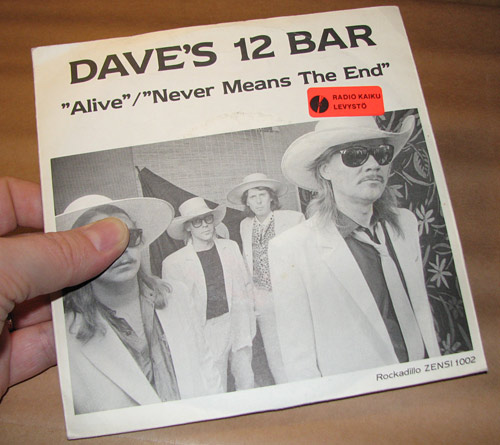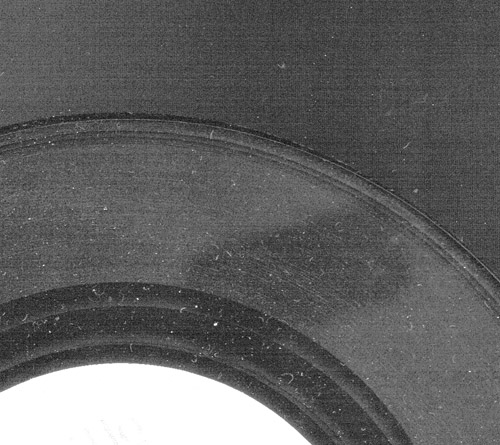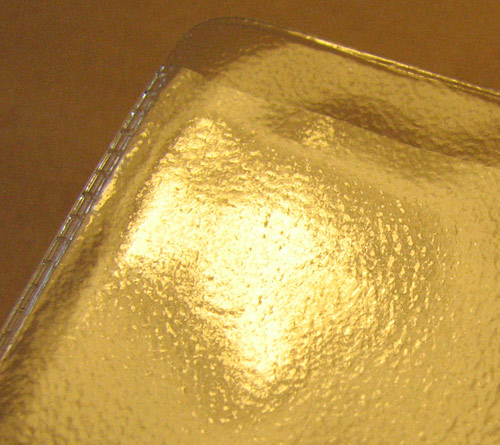The following subject hasn't really got anything to do with Hendrix per se. But as it does affect all collectors of vinyl and vinyl is what we collect here I'm publishing it as a warning to others and in the hope that the word will spread. It's a long text but the problem is a big one so I urge all vinyl collectors to read it through carefully.
A BIT OF HISTORY
Most vinyl collectors probably have at least once come across a (black) vinyl lp or single that had odd mat gray patches or was gray all over. I'd had a few records like that over the years, when they were singles I though that they may have been used in a jukebox where wear, cigarette smoke residue and other goo had accumulated on the playing surface hiding that vinyl shine. But the gray couldn't be washed off, nor could lps with gray areas be cleaned with any method that I tried.
As I rarely came across these records I mentally filed the whole question away as one of life's unexplained mysteries. Then in 2012 in Record Collector issue 402 someone wrote in and asked for an explanation for this phenomena, called "fogging" in the letter. RC editor Ian McCann replied and suggested that it was caused by moisture. In issue 404 a letter from another reader finally offered a plausible explanation:
The stiff transparent PVC sleeves (the kind that for example picture discs are often packaged in) which have been sold forever with the promise of maximum protection use a chemical substance called a plasticizer to keep the plastic soft. Over time the plasticizer disintegrates and in the process releases gases. These gases corrode the surface of vinyl records (and sleeves and labels, more of that later) turning them gray.
I immediately went through all my lps taking out those housed in thick PVC sleeves but could find very few examples with noticeable damage so assumed that this problem did not occur very often. I did however remove all of the sleeves that I could find, just in case. The lps that I did find that had been affected had mainly been bought second hand already housed in an old PVC sleeve and had most likely been in storage since the 70s. So I concluded that the problem rarely occurred and if it did it took decades to cause serious damage. Unfortunately I was very much mistaken.
In 2009 I had moved to a much smaller apartment, as a consequence a lot of my records have been stored away in boxes as there just isn't space to keep everything handy all of the time. Every now and then I put one box away and in turn take another one out of storage and play the discs. A while ago I did so with a box of singles that had been stored away for a few years and noticed that a lot of the singles were housed in thick PVC sleeves. I checked one, checked another...to my horror half of the singles in the box were now gray.
How could this have happened after I had concluded that the problem was rare? For a very simple reason. The singles had been stored in a box with no ventilation so the fumes had accumulated in all peace inside the box and had corroded not only the singles in them but also the singles next to them. The way that you insert the records into the outer sleeves also makes a big difference. If you have been in the habit of inserting the record with the sleeve opening in the same direction as the sleeve opening of the outer sleeve the disc is ventilated much more effectively than with the sleeve opening next to a closed seam of the outer sleeve. Unfortunately I've always put the sleeve opening to face a closed seam of the outer to prevent dust from entering, thus lessening the ventilation.
A couple of singles didn`t even come out of their paper sleeves anymore. It turned out that the paint / ink used to print the on-disc labels manufactured by Polydor and some other labels in the 70s and 80s gets soft and sticky when exposed to the PVC plasticizer gases and then gets stuck to the paper sleeves as a consequence.
After finding that box of horrors I checked the Hendrix boxes and pretty much the worst had happened. About 50 singles were now more or less gray (and they weren't all easy to replace cheap ones either), a couple of 70s Polydor singles with printed on labels didn't even come out of their sleeves anymore. I'd like to say that I took it like a man and didn't cry but I'd probably be lying...
The reason very few of my lps had been affected is simple: I had kept them mainly on shelves where there's ventilation as they are in an open space and also get shuffled around every now and then when I pull an album out to play. Also lps have sleeves and inner sleeves which in many cases prevents the fumes from getting in touch with the vinyl, especially older discs with thick cardboard inners. 7" singles however mainly have very thin sleeves which the gases go right through.
One particular single from my collection perfectly illustrates the problem. This disc has a thick sticker on the sleeve, the vinyl was completely gray EXCEPT for the spot that had been under the sticker glued on the sleeve. The combined thickness of the sticker and the sleeve had been great enough to prevent the gas from penetrating and a corresponding spot of unharmed vinyl had remained.
Vinyl is unfortunately very hard to photograph as it reflects everything, I failed to get a good photo of the disc but scanning the vinyl and then adjusting the contrast brought out the mark left on the record. Still a fuzzy picture, sorry about that but it does give you some idea of what had happened.

THE 45 SLEEVE WITH A STICKER ON IT

THE 45 WITH THE UNAFFECTED STICKER SHAPED -PATCH OF VINYL

THE KILLER PVC SLEEVE
So, to recap, here's what I've found out (so far):
Problem sleeves
The only sleeves that seem to cause this problem are the thick PVC sleeves, the kind used for many picture discs and often (mainly in the past) used by record shops and dealers. I haven't come across any other sleeves that would have disintegrated and in the process damaged the vinyl inside. These PVC sleeves use a plasticizer to keep them soft, when the plasticizer disintegrates over the years the sleeves become hard and brittle, the gases that are release in the process corrode the surfaces of the vinyl records inside the sleeves or next to them. These sleeves often (but not always) have slightly textured surfaces and the edges have been pressed together, often with a kind of "perforation" effect (see the picture above). They are prone to crack and easily get split at the seams, increasingly so with age. In the 70s and 80s they often came with an address of the record shop the sold the disc printed on them.
The consequences
Vinyl first gets gray spots, then over time becomes completely gray. And I say "gray" as that's what it looks like on a black vinyl disc. Colored and transparent vinyl is affected in exactly the same way but the damage is much harder to see. Light grayness or grey spots aren't necessary audible but when the corroding gets worse you can hear it as increased surfaces noise, a heavy swooshing. Of course any grayness spoils the disc visually and lessens it value even if it remains playable. Some labels printed with paint / ink directly on vinyl get sticky and in worst case get permanently stuck to the inner sleeve. I've also come across some lp sleeves that have gotten sticky (for some reason especially those manufactured by CBS). Most likely the lamination, the thin layer of plastic that the sleeves have been coated with, has gotten soft from the plasticizer gases. Some older inner sleeves that have been lined with plastic have also been affected with the lining sticking to the vinyl and leaving a pattern that looks like water ripples. This seems to be rare but I've seen a couple. Some singles and lps originally came with plastic outer sleeves (like those nowadays put out by Music On Vinyl). If such sleeves are stored in PVC sleeves they become "wavy" very quickly as the plasticizer fumes soften the outer bag. Photocopied paper sleeves get very easily stuck to the PVC sleeves when the gases soften the copier ink. Basically, if anything is sticky or looks "melted" or gray the reason very likely is that it has been stored inside or near a PVC sleeve.
What to do?
Unfortunately I'm not aware of any way of reversing the damage and there probably isn't one. I'd urge everyone to immediately remove all vinyl records from PVC sleeves. If the PVC sleeve is part of the original packaging of a record I've removed it and stored it separately with no record inside. Even keeping the PVC sleeves separately next to the records will over time damage them so they need to be completely removed. The safest outer sleeves are ones made of Mylar but those are quite expensive. Polythene and related plastics would seem to be safe as well, I haven't found any problematic examples, these are the slightly "milky" soft sleeves that come in different thicknesses. Basically all outer sleeves except ones made from PVC would seem to be safe or at least won't destroy your disc in just a couple of years.
So, I've made two mistakes in the past, I've stored my most valuable records in the thickest PVC sleeves I had as I thought that was the safest way to store them, and I then neatly archived them in boxes with lids to prevent dust from entering thus killing off any ventilation. This made sure that they got damaged. The lesson is, records like to be played, not stored away!
Unfortunately PVC sleeves are still being manufactured and sold all over the world. I cannot understand how this problem seems to be almost completely unknown to everybody in the record collecting world. These are mainly my experiences and observations, other may have different stories to tell, comments and / or more scientific analysis of the problem are most welcome and I'll add to this article if new information or tips emerge.
















